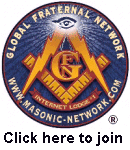
The GFN Treasure Chest Archives
www.masonic-network.com
"Where Master Masons Communicate"

 |
The GFN Treasure Chest Archiveswww.masonic-network.com |
 |
LABOR
It is one of the most beautiful features of the Masonic Institution, that it
teaches not only the necessity, but the nobility of labor. From the time of
opening to that of closing, a Lodge is said to be at labor. This is but one of
the numerous instances in which the terms of Operative Masonry are symbolically
applied to Speculative; for, as the Operative Masons were engaged in the
building of material edifices, so Free and Accepted Masons are supposed to be
employed in the erection of a superstructure of virtue and morality upon the
foundation of the Masonic principles which they were taught at their admission into
the Order.
When the Lodge is engaged in reading petitions, hearing reports, debating financial matters, etc., it is said to be occupied in busyness; but when it is engaged in the form and ceremony of initiation into any of the Degrees, it is said to be at work. Initiation is Masonic labor. This phraseology at once suggests the connection of our Speculative System with an Operative Art that preceded it, and upon which it has been founded. Gadicke says: Labor is an important word in Freemasonry- indeed, we might say the most important. For this, and this alone, does a man become a Freemason.
Every other object is secondary or incidental. Labor is the costumed design of every Lodge meeting. But do such meetings always furnish evidence of industry? The labor of an Operative Mason will be visible, and he will receive his reward for it, even though the building he has constructed may, in the next hour, be overthrown by a tempest. He knows that he has done his labor. And so must the Freemason labor. His labor must be visible to himself and to his Brethren, or, at least, it must conduce to his own internal satisfaction. As we build neither a visible Solomonic Temple nor an Egyptian pyramid, our industry must become visible in works that are imperishable, so that when we vanish from the eyes of mortals it may be said of us that our labor was well done. As Freemasons, we labor in our Lodge to make ourselves a perfect building, without blemish, working hopefully for the consummation, when the house of our earthly tabernacle shall be finished, when the Lost Word of Divine Truth shall at last be discovered, and when we shall be found by our own efforts at perfection to have done God service.
MacNulty, Freeasonry, A Journey through Ritual and Symbol:
Approaches to Masonic Labour
As there are three doors in the west wall of the Gothic cathedral, so
there are three traditional ways to gain access to the temple of the human
interior: action, devotion and contemplation. Since each way makes its own demands
and has its own risks, European Masons provide an opportunity for applicants
to take thought before joining the Order, which uses all three. In the
Dunkelkammer, or chambre de réflexion the prospective Candidate sits soberly
alone and writes his reasons for wishing to join the order. Only after his
motives have been reviewed by the Brethren is he accepted as a Candidate.
Ritual is the way of action. Its use in the dramas which constitute the
Degrees make it the Crafts principal teaching method. By observing himself
as he plays his role in the initiation of the Candidate, each Mason comes to
know himself in the context of teaching a Brother.
Devotion, the way of the heart, appeals most to persons with strong
feelings. Followers of the way of devotion make extensive use of prayer,
meditation, obedience, and loving service. Freemasonrys devotional aspects show most
clearly through its charitable works.
Contemplation is the way of the thinker. In following this way, the
Mason becomes conversant with the symbols and the principles they represent; then
he observes these principles functioning in his own experience.
Naudon, The Secret History of Freemasonry:
The sacred character attached to labor continued with the rise of
Christianity and in fact was reinvigorated and rejuvenated by the new religion,
which enabled labor subsequently to acquire an even higher value. This effect,
which is often overlooked, is of the utmost importance, for it appears in all
the social and political upheavals that have taken place throughout the history
of labor. Throughout the centuries the Church unfailingly proclaimed and
continually developed this principle: Labor is the image of Divine Creation.
The influence of the Church was first felt on the ethical plane,
resulting in the dignification of labor and the protection of the humiliores against
the powerful in institutions. The earliest constitutions ordered that work be
remunerated, and little by little slavery diminished and the fate of serfs
gradually improved.
According to the Christian concept of labor, each trade was placed under
the protection of a patron saint, who acted as an intercessor with the power
on high. Over the centuries these saints became increasingly involved with
peoples everyday lives. But the relationship between artisan and the higher
power extended much further than this. Christian religion teaches that we carry
within us the divine virtues; we are, in effect, a temple for them. In
following the exemplary life shown by Christ, we are able to attain perfection and,
through the action of Christ within us, ensure that Christ lives. In our
work we are thus a participant in the creative power of God.